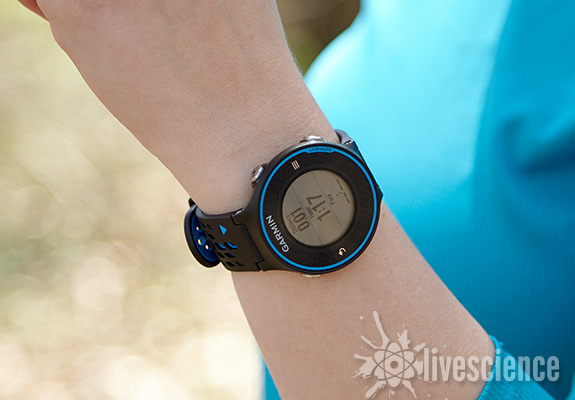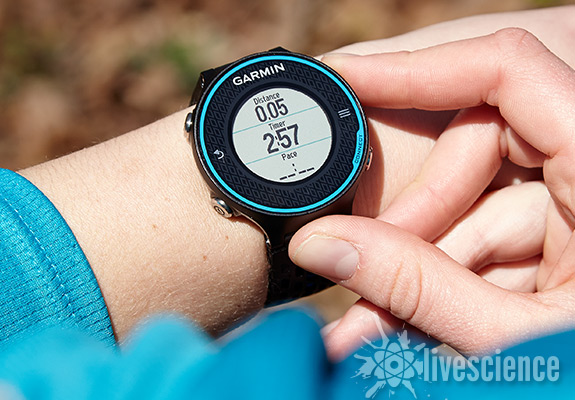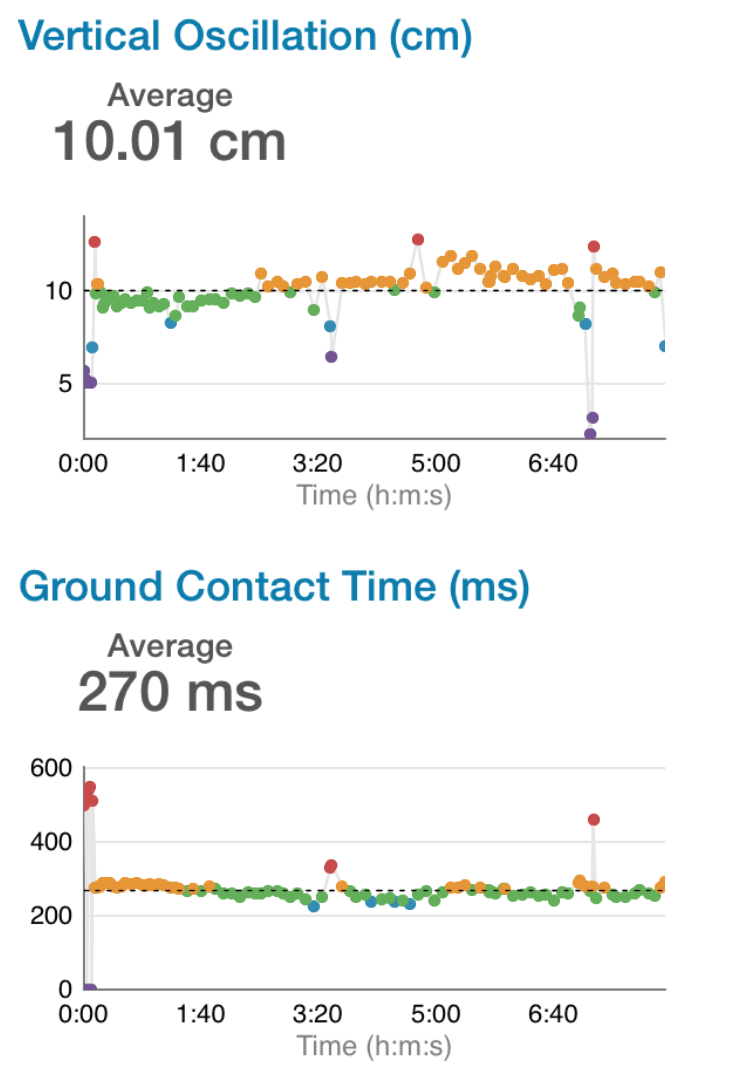Garmin Forerunner 620: GPS Watch Review

The Garmin Forerunner 620 (FR620) is a GPS watch for runners. The watch is one of the only GPS running watches on the market with a color display and touch screen. At $370, the FR620 (and the compatible HRM-Run heart-rate strap) is rich in features but falls at the high end of the price range for GPS running watches. The TomTom Runner Cardio, a GPS watch with a built-in heart-rate sensor, retails for $270 on Amazon. And Garmin's Forerunner 220 tracks fewer metrics than the FR620 but will set you back only about $235.
I wore the FR620 for two weeks, bringing it with me on runs and even taking it for a dip in the pool to test its water resistance. Here's what I found:
Overall rating: 6/10
The Forerunner 620 tracks advanced metrics that serious runners will find useful. The device's live-tracking feature also provides a great way to keep your friends and family in the loop during a race.
However, the watch lacks the daily activity-tracking features and smartphone notifications (such as texts and calls) that now come standard on many GPS running watches. [Best GPS Running Watches]
Design/Comfort: 6/10

The FR620 is a comfortable watch, and although I wouldn't consider it stylish, it is attractive enough to wear all day like a regular wristwatch. It has a large, circular face that's easy to read while running, and the screen is fairly bright, so you don't need to keep pressing the backlight button. I had no trouble reading the watch on outdoor runs or while inside the house. The watch also has a color display, which is supposed to make the screen even easier to read, but I didn't think this feature did much to improve the visibility of the display.
The FR620 is one of the few GPS running watches with a touch screen, but it also has four conventional buttons. This particular combination of physical buttons and touch-screen buttons did not seem intuitive to me. I had to read (and re-read) the user manual to get the hang of navigating through the watch's many features. Other GPS watches — like the Fitbit Surge and the Garmin Vivoactive — also have touch screens and physical buttons, but I found them easier to use.
Sign up for the Live Science daily newsletter now
Get the world’s most fascinating discoveries delivered straight to your inbox.
According to Garmin, you can use the FR620 for about 10 hours when GPSis enabled, and the battery will last for about six weeks in standby mode (i.e., when GPS is switched off). I had to charge the watch only once during my two weeks of testing, which leads me to believe that Garmin's battery-life claims are true. I liked that you could see how much battery you had left just by looking at the little battery icon on the home screen. Some watches make you scroll through menus to find out if you still have a charge.
The FR620 comes in two color combinations: black with blue accents, and white with orange accents. I don't particularly like either of these options, and I wish the watch came in solid black or white. However, I was impressed that the watch is fully waterproof. I wore it for an entire swim workout without experiencing any problems. And if all you really want to do is time your workout in the pool, you can certainly do so with the FR620 (though both Garmin and Swimovate make cheaper watches built just for tracking swimming metrics). [Best Fitness Trackers for Swimmers]
User-friendliness: 5.5/10
To get started with the FR620, you'll need to download Garmin's software onto your computer and then plug the watch in using the USB-connected charging port. If you don't have a Garmin account already, you'll be prompted to create one. Once you have an account, you can analyze all the data you collect with the watch on the Garmin Connect website or mobile app. You can either upload data via Bluetooth from your device to the mobile app or plug the watch into your computer to transfer data.
I tried syncing data both ways (wirelessly and via the USB charging cord) and never had any problems. However, the FR620 also lets you send data via a Wi-Fi network, which is great for people who don't have Bluetooth-enabled smartphones. However, I couldn't get the Wi-Fi data transfers to work. I tried to set up several different networks through Garmin Express, but I always got an error message when I tried to transfer data that way. It's possible that I was doing something wrong, but numerous Amazon reviewers have encountered similar Wi-Fi connectivity problems with the FR620.
The Garmin Connect mobile app is fine for viewing an overview of your workout and providing graphs of your cadence, pace or elevation over time. However, I preferred viewing my stats on the Garmin Connect website, which was easier to navigate and had a less-cluttered feel than the mobile app.
If you buy Garmin's HRM-Run heart-rate strap to wear during your runs, you'll be able to collect metrics (like vertical oscillation and ground contact time) that other heart-rate straps don't measure. But the watch is also compatible with non-Garmin heart-rate straps that use ANT+ (a wireless technology that allows for data to be sent between the strap and your watch). Before you start using any heart-rate strap or other sensor, you'll need to manually pair it with the FR620 by entering the Settings menu and selecting the sensors page. This pairing process wasn't difficult, but other watches I've tested can automatically pair with heart-rate monitors without requiring me to press any buttons.
Value of information: 6/10
The basic metrics that the FR620 tracks are distance and pace. When you pair the watch with Garmin's HRM-Run heart-rate strap, you can also track your heart rate, cadence (strides per minute), ground contact time (the amount of time your foot stays on the ground with each step) and vertical oscillation (your movement up and down, or "bounce"). As an amateur runner, I found these advanced metrics to be a little over my head. However, the Garmin Connect site does a good job of explaining what these measurements mean and also provides data that let you compare your stats to those of other runners.

Wearing a heart-rate strap with the FR620 will also let you collect other data about your runs, including recovery time, or the amount of rest you should take before attempting another strenuous workout; and estimated VO2 max, or aerobic capacity, which is a good measure of endurance. Both of these metrics are valuable for serious runners or anyone who wants to see how their endurance is building over time.
The FR620 automatically goes into GPS mode when you start a new run, but you can turn off the GPS by tapping on the icon at the top of the screen. Using the GPS mode drains the watch's battery pretty quickly, so you should turn off the GPS when you're running indoors. I never had trouble picking up a GPS signal with the FR620. It took longer for the watch to acquire a signal when I was standing in Midtown Manhattan, surrounded by tall buildings. But out in the suburbs, the watch consistently picked up a satellite signal in less than 30 seconds.
I did encounter one strange incident when the watch tracked only a tiny portion of my run using GPS data. (When I uploaded the run, the map only showed me crossing the street in front of my house, when I had actually run 3 miles, or about 5 kilometers). But even though the GPS cut out in this instance, the watch continued to track my other data accurately, and I didn't experience the problem again.
Although the FR620 was originally released as a runners-only GPS watch, Garmin updated its software to include cycling functionality last year. You can put the watch in Ride mode to track distance while cycling, and you can also pair the watch with external sensors to get more in-depth cycling data, including speed and cadence. [Best Fitness Tracker Bands]
Motivation/Inspiration: 6.5/10
The FR620 is missing the daily activity-tracking capabilities you'll find on newer Garmin GPS watches, like the Vivoactive and the Forerunner 920XT. This means you can't use the watch to track your steps. And unlike Garmin's newer models, you can't receive notifications from your smartphone on the FR620 via Bluetooth. However, the watch does have a live-tracking feature that lets you share your GPS data in real time with people who might be interested (e.g., family members who are cheering you on during a race). You can also invite Facebook and Twitter friends to see your live-tracking data.
The FR620 saves files in a .FIT format, which makes it easy to transfer the data that the watch collects to third-party sites, like Strava or MyFitnessPal. Garmin Connect also seconds as a social networking site for athletes who want to share their stats. Through the app, you can share information about your runs with friends, join fitness-related groups and connect with other Garmin-toting athletes in your area.
Overall, my time with the FR620 was positive. However, this running watch is definitely a tool for serious athletes, and it might be overkill for casual or novice runners. If your objective is to track your general activity and some information about your workouts, a GPS watch with activity-tracking features, plus a few different sport modes (such as running, cycling or walking) might suit you better. If that's more in line with your interests, then the Fitbit Surge and Garmin Vivoactive are both top contenders in that category.
More reviews: See all our GPS watch reviews to find the best one for your needs.
Follow Elizabeth Palermo @techEpalermo. Follow Live Science @livescience, Facebook & Google+.

Elizabeth is a former Live Science associate editor and current director of audience development at the Chamber of Commerce. She graduated with a bachelor of arts degree from George Washington University. Elizabeth has traveled throughout the Americas, studying political systems and indigenous cultures and teaching English to students of all ages.









